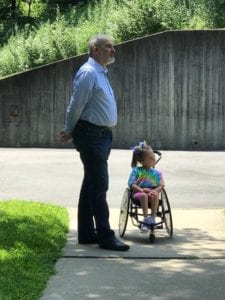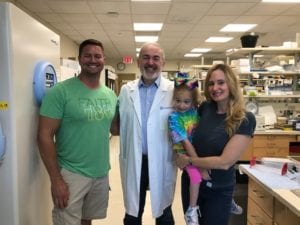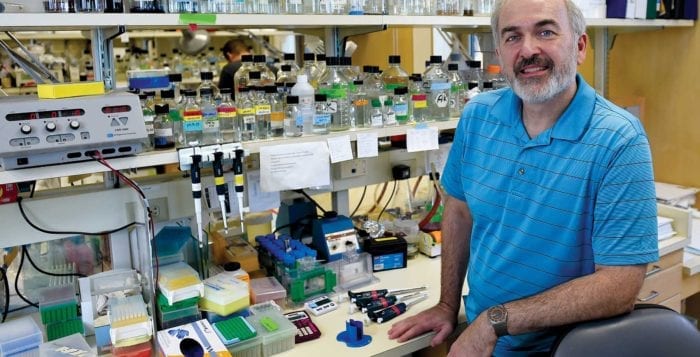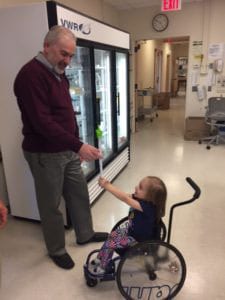By Daniel Dunaief
This Sunday, Adrian Krainer is traveling to California to visit with Emma Larson, a Middle Island girl whose life he helped save, and to see an actor who played the fictional super spy James Bond.
A professor at Cold Spring Harbor Laboratory, Krainer is the recipient of the Breakthrough Prize in Life Sciences, which noted Silicon Valley benefactors including Facebook’s Mark Zuckerberg and Google’s Sergey Brin financed seven years ago. Pierce Brosnan will host the event, which National Geographic will broadcast live starting at 10 p.m. Eastern time.

Krainer will split the $3 million prize money with Frank Bennett, a senior vice president of research and a founding member of Ionis Pharmaceuticals. The duo helped develop the first treatment for spinal muscular atrophy, the leading genetic cause of death among infants, which affects 1 in 10,000 births.
Prior to the Food and Drug Administration’s approval of Ionis and Biogen’s treatment, which is called Spinraza, people with the most severe cases of this disease lost the ability to use their muscles and even to breathe or swallow. Many children born with the most severe symptoms died before they were 2 years old.
“No one deserves it more,” said Dianne Larson, whose 5-year-old daughter Emma has been in a trial for the drug Krainer helped develop since 2015. When Emma started the trial as a 2-year-old, she couldn’t crawl anymore. Now, she’s able to push herself in a wheelchair, stand and take steps while holding onto something. Emma refers to Krainer as the person who helped make “my magic medicine.”
People with medical needs “kind of take for granted that there’s a medicine out there,” Larson said. “You don’t think about the years of dedication and research and hours and hours and money it costs to do this.”
Bruce Stillman, president and chief executive officer at Cold Spring Harbor Laboratory, said that this award was well deserved and was rooted in basic science. Krainer’s “insights were substantial and he realized that he could apply this unique knowledge to tackle SMA,” Stillman wrote in an email. “He did this with spectacular results.”

Children with the most severe case of this disease had faced a grim diagnosis. “Now those children have a treatment that will keep them alive and greatly improve the prospects for a normal life,” Stillman added.
New York recently added SMA to its newborn screening test.
Krainer, who specialized in a process called RNA splicing during his research training, began searching for ways to help people with spinal muscular atrophy in 2000.
SMA mostly originates when the gene SMN1 has a defect that prevents it from producing the SMN protein, called survival of motor neuron. This protein is important for the motor neurons, the nerve cells that control voluntary muscles.
As it turns out, people have a backup gene, called SMN2, which produces that important protein. The problem with this backup gene, however, is that it produces the protein in lower amounts. Additionally, RNA gene splicing leaves out a segment that’s important for the stability of the protein.
Looking at the backup gene, Krainer began his SMA work by seeking to understand what caused this splicing inefficiency, hoping to find a way to fix the process so that more function protein could be made from the SMN2 gene.
Collaborating with Bennett since 2004, Krainer developed and tested an antisense olignucleotide, or ASO. This molecule effectively blocked the binding of a repressor protein to the SMN2 transcript. By blocking this repressor’s action, the ASO enabled the correct splicing of the survival of motor neuron protein.

At first, Krainer tested the cells in a test tube and then in culture cells. When that worked, he went on to try this molecule in an SMA mouse model. He then worked with Ionis Pharmaceuticals and Biogen to perform the tests with patients. These tests went through hundreds of patients in numerous countries, as diseases like SMA aren’t limited by geographic boundaries.
“Everything worked” in the drug process, which is why it took a “relatively short time” to bring the treatment to market, Krainer said.
People who have worked with Krainer for years admire his character and commitment to his work.
Joe and Martha Slay, who founded the nonprofit group FightSMA, helped recruit Krainer to join the search for a treatment.
Joe Slay recalls how Krainer made an effort to meet with children with SMA. He recalls seeing Krainer during a pickup football game, running alongside children in wheelchairs, handing them the ball and tossing it with them.
Krainer brought his family, including his three children, to meet with the SMA community. The trip had a positive effect on his daughter Emily, who said it “subliminally had an impact on wanting to work in this field.”
Currently a third-year resident in a combined pediatric neurology residency and fellowship program, his daughter is “very excited for him and proud.” She recalls spending Christmas holidays and New Years celebrations at the lab, where she met with his friends and co-workers.
Emily Krainer said a few people in her residency know about the role her father played in developing a treatment the hospital is employing.
The treatment is the “talk of child neurology right now,” she said.
Researchers hope the recognition for the value of basic research that comes with the breakthrough prize will have an inspirational effect on the next generation.
“The idea of prizes like this is to highlight to the public that scientists spend many years working without public recognition but make really important contributions to society,” Stillman suggested.
For Larson, the research Krainer did was key to a life change.
“To me, science is hope,” Larson said. “If we didn’t have this science, we wouldn’t have any hope,” adding that she would like her daughter to become a scientist someday.









